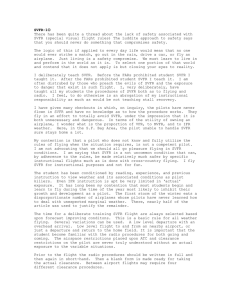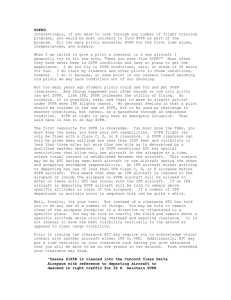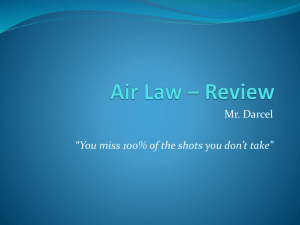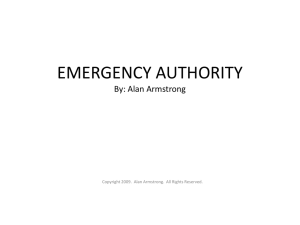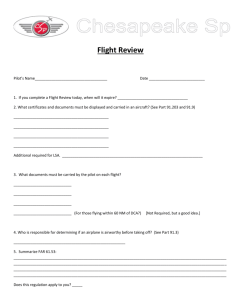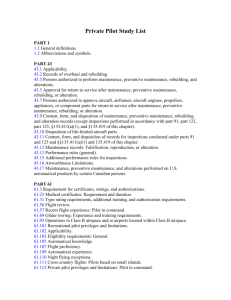The purpose of SVFR is to make possible arrivals, departures... Classes C, D, E and some B controlled airspace under... Special Visual Flight Rules --SVFR
advertisement
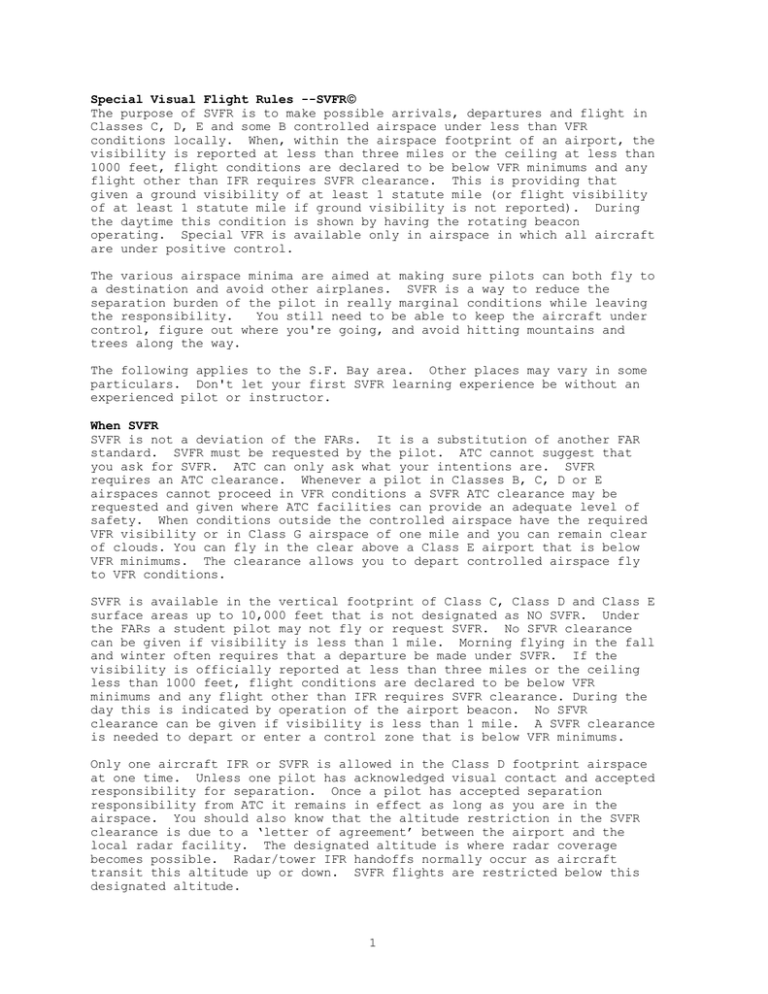
Special Visual Flight Rules --SVFR The purpose of SVFR is to make possible arrivals, departures and flight in Classes C, D, E and some B controlled airspace under less than VFR conditions locally. When, within the airspace footprint of an airport, the visibility is reported at less than three miles or the ceiling at less than 1000 feet, flight conditions are declared to be below VFR minimums and any flight other than IFR requires SVFR clearance. This is providing that given a ground visibility of at least 1 statute mile (or flight visibility of at least 1 statute mile if ground visibility is not reported). During the daytime this condition is shown by having the rotating beacon operating. Special VFR is available only in airspace in which all aircraft are under positive control. The various airspace minima are aimed at making sure pilots can both fly to a destination and avoid other airplanes. SVFR is a way to reduce the separation burden of the pilot in really marginal conditions while leaving the responsibility. You still need to be able to keep the aircraft under control, figure out where you're going, and avoid hitting mountains and trees along the way. The following applies to the S.F. Bay area. Other places may vary in some particulars. Don't let your first SVFR learning experience be without an experienced pilot or instructor. When SVFR SVFR is not a deviation of the FARs. It is a substitution of another FAR standard. SVFR must be requested by the pilot. ATC cannot suggest that you ask for SVFR. ATC can only ask what your intentions are. SVFR requires an ATC clearance. Whenever a pilot in Classes B, C, D or E airspaces cannot proceed in VFR conditions a SVFR ATC clearance may be requested and given where ATC facilities can provide an adequate level of safety. When conditions outside the controlled airspace have the required VFR visibility or in Class G airspace of one mile and you can remain clear of clouds. You can fly in the clear above a Class E airport that is below VFR minimums. The clearance allows you to depart controlled airspace fly to VFR conditions. SVFR is available in the vertical footprint of Class C, Class D and Class E surface areas up to 10,000 feet that is not designated as NO SVFR. Under the FARs a student pilot may not fly or request SVFR. No SFVR clearance can be given if visibility is less than 1 mile. Morning flying in the fall and winter often requires that a departure be made under SVFR. If the visibility is officially reported at less than three miles or the ceiling less than 1000 feet, flight conditions are declared to be below VFR minimums and any flight other than IFR requires SVFR clearance. During the day this is indicated by operation of the airport beacon. No SFVR clearance can be given if visibility is less than 1 mile. A SVFR clearance is needed to depart or enter a control zone that is below VFR minimums. Only one aircraft IFR or SVFR is allowed in the Class D footprint airspace at one time. Unless one pilot has acknowledged visual contact and accepted responsibility for separation. Once a pilot has accepted separation responsibility from ATC it remains in effect as long as you are in the airspace. You should also know that the altitude restriction in the SVFR clearance is due to a ‘letter of agreement’ between the airport and the local radar facility. The designated altitude is where radar coverage becomes possible. Radar/tower IFR handoffs normally occur as aircraft transit this altitude up or down. SVFR flights are restricted below this designated altitude. 1 Class B Airspace Class B has a modified version of SVFR always available without SVFR clearance requirement. Contrary to some thinking this SVFR is not analogous to Class B airspace since visibility requirements are lower in SVFR and collision avoidance is provided in SVFR by exclusion of other aircraft. The VFR flight visibility of three miles in Class B airspace is not changed but distance-to-clouds minima of ‘clear of’ are set primarily to try to avoid midair collisions, especially between VFR aircraft and IFR aircraft which may be popping out of clouds. Where Class B surface area primary airport data on the sectional restricts SVFR flight you should know that the restriction applies only to fixed wing aircraft. The basic restrictions to VFR flight in SFO Class B airspace is clear of clouds and three mile visibility in your flight direction is not identical to SVFR. SVFR can be used in Class B by helicopters. Night SVFR Night SVFR must have both pilot and aircraft equipped and qualified for IFR (91.157b4). With the FAR change in night visibility requirements for VFR is 3 miles 500/1000//2000. Above 1200' AGL and 10,000 MSL to 5 miles 1000/1000/1 mile. It would appear that even a SVFR clearance in Class D airspace would present a problem for a pilot attempting to leave the IFR class surface area at night unless certain of the visibility and cloud clearance. Safe SVFR is much like safe sex...come prepared SVFR is a very useful way for the qualified pilot to make better use of his aircraft and the airspace. Qualified in this instance has nothing to do with total experience or ratings. SVFR qualified means knowledgeable. One thing about SVFR is that it may be allowed when conditions are below minimums for an IFR approach, but still be legal to land under SVFR! There are many circling IFR approaches which require visibility better than a mile. The expectation of a successful landing or VFR conditions requires that the pilot get the best weather information. Listening to local aircraft communications and active participation or queries should influence your flight decisions. Special VFR allows pilots to fly in Marginal-VFR or worse conditions. There is no guarantee that you will be able to do this without getting into trouble. You still can't fly in the clouds...but you can fly a lot closer than in VFR conditions and in much lower visibility. This allows VFR traffic in and out of D and C airspace when the weather is bad. SVFR lets you go from uncontrolled airspace to a landing at an airport with Class D airspace by adjusting the allowable minimums. SVFR should be part of your training experience. A pilot should never, repeat never, attempt to use SVFR until he has made several flights with an instructor or pilot who has made SVFR flights in the area and who knows both the legal and safety requirements involved. SVFR is not something you should learn on your own. Many FBO's insurance limit non-instrument rated pilots to the basic VFR weather minimums (i.e., no specials). Low Visibility SVFR The poor visibility of SVFR provides pilots with four areas of difficulty attitude control, navigation, avoiding impact with terrain, and avoiding impact with other aircraft. A weather front or radiation fog can create SVFR conditions due to visibility. Radiation fog may often linger all day. Ceilings will be reported as indefinite. Even with one mile ground visibility the slant range visibility may make the only viable approach be from overhead. The fog may be anywhere from 400 to 1000’ feet thick 2 vertically. The airport is completely visible only from overhead. In this case the SVFR clearance will direct the pilot to report above the airport at a specified altitude in VFR conditions to await a SVFR clearance. When traffic conditions allow, the SVFR flight will be directed to descend in the pattern for landing. A corresponding departure may be directed to climb in the pattern and report reaching VFR. SVFR may be allowed to enter or leave if ATC can pass the visual separation responsibility over to the SVFR pilot. (I was recently cleared SVFR from over the airport after I reported departing IFR aircraft in sight.) Low Ceiling SVFR Still SVFR does not need to be always flown in poor visibility. It just as likely, and even more likely to be flown in good visibility but under low ceilings. This particular type SVFR is caused by avection fog conditions. Avection fog forms a layer anywhere from 400 to 2000’ thick. It will ride like a blanket in and out from the ocean over the land for many miles. How far inland it goes is pretty much determined by the inland temperatures the day before. The hotter the Central Valley of California the further inland will intrude the avection fog. This fog can extend clear across the valley. It moves in and out from the ocean in about four day cycles depending on the interior temperatures. By learning to read the changes you can predict SVFR conditions. It is possible for a SVFR flight to make a safe arrival at an airport when an IFR flight might not. Once cleared into or out of the Class D or C airspace the SVFR flight has no minimum altitude restriction. You can remain as close to the clouds as you want but must have 1 mile visibility in the flight direction. You could arrive/depart at 300' under SVFR conditions where the IFR pilot would have 400' descent minimums and never see the airport. These flight conditions are not unusual with avection fog in coastal regions. Occasionally, ATC may delay giving you your SVFR clearance and ask you to report a geographic point just outside the airspace footprint. This enables ATC to slip your SVFR flight, into the airspace with a clearance not possible from farther out due to IFR traffic. When cleared, I was less than three minutes from a safe arrival and landing. Knowing what is legal and safe in minimum conditions should be required knowledge. You never know when you will need SVFR. I arrived at my home airport when all IFR traffic was unable to breakout at minimums. I chose to come into the airport from the non-IFR approach side. Went underneath about 10 miles out in ten mile visibility over flat terrain. I called up for SVFR clearance, but had to wait for an IFR traffic break while I circled outside the airspace. Flew up to the airspace limit line, got a SVFR clearance, and waited about five minutes for an IFR guy to get clear. Was cleared for SVFR and the tower had me in sight three miles out because I knew exactly where I was and gave a precise position report. No problem, legal, safe, and practical. Knowing what can be done both safely and legally is important. Instructors should take students who live in coastal regions subject to avection fog on several SVFR flights. It is important to experience, first hand, the limitations and potentials of SVFR flight. 3 The Clearance Historical note: Since SVFR has essentially 'canned' arrival/departure procedures, for many years a pilot could obtain a "Card-a-Clearance" and a number. You just had to give your card number and direction you wanted to fly. Must have made things too easy. They stopped using it. You can make your own card-a-clearances on the back of your lapboard. One for departures and one for arrivals. The only things that ever change may be reporting points, direction and specific instructions. The SVFR clearance is a sequential communication from ATC that gives specific limits and procedures for either an arrival, departure, or flight through Class C or D airspace. To obtain the proper clearance you must both know where you are and the direction of entry, departure, or flight through the airspace. The pilot must request the SVFR clearance. ATC is limited to asking, “What are your intentions.” the pilot is responsible in obtaining and acknowledging full understanding of the clearance. Any deviation in flying the clearance is a violation of the applicable FARs. The SVFR clearance places responsibility for altitude, visibility, and reporting conditions on the pilot. Such a clearance has a certain sequence of information. 1. Type/full number of aircraft 2. Is cleared out of/into Airport’s Class D airspace 3. Direction out/in 4. Maintain SVFR while in the Class D airspace 5. At or below an altitude (500' below minimum radar vectoring altitude. 6. Report clear/entering the Class D airspace or VFR FAR 91.157 VISUAL FLIGHT RULES: Special VFR Weather Minimums (b) Special VFR operations may only be conducted (1) With an ATC clearance; (2) Clear of clouds; (3) Except for helicopters, when flight visibility is at least 1 statute mile; and (4) Except for helicopters, between sunrise and sunset (or in Alaska...) unless (i) The person being granted the ATC clearance meets the applicable requirements for instrument light under Part 61 of this chapter; and (ii) The aircraft is equipped as required in 91.205(d). SVFR Limitations SVFR is not a temporary Class G airspace, either. In class G airspace, no separation is provided by ATC even with radar. Under SVFR the only separation provided by ATC is by clearing only one aircraft into the airspace at a time. Non-radar ATC has separation responsibility only when both aircraft are on the ground. Many pilots have a mistaken idea that under VFR, IFR and SVFR you always receive ATC separation services. Not so. A SVFR clearance effectively provides you with services in a like manner to IFR aircraft, that is, one aircraft at a time into the airspace unless one aircraft or the other takes on separation responsibility. In order to grant you an SVFR, the controllers must ascertain that your SVFR will not delay any IFR flights. If you try it, you will probably discover just how long it takes you to fly 5 NM (about 3 minutes in a Skyhawk). This distance is the minimum IFR separation. 4 Just as the biker can best protect himself from automobiles through knowledge of their performance capabilities and rules, so can the VFR/SVFR pilot benefit from knowledge of IFR. Stay clear of IFR approaches, check points and altitudes. Under SVFR the VFR pilot is actually flying in IFR conditions. Normally, SVFR flights are required to remain clear or denied takeoff clearance if an IFR flight is present. IFR flights have priority. If the VFR pilot will listen carefully on the radio he will hear IFR flights being given specific reporting points and routes. Become familiar with both the routes and points so as to remain clear or know where to look for traffic. SVFR is a good thing to keep in mind for landing if the weather turns bad on you. If you can't do IFR and ATC won't allow VFR, requesting SVFR can get you down safely. I makes me wonder who, in his right mind, would ask for an SVFR at night if he already has an instrument rating? A pilot who is so doubtful of his remaining fuel that he wants the quickest way in could well opt for the SVFR. SVFR should never be attempted unless the pilot is VERY familiar with the airport and surrounding area. You must know well all arrival checkpoints from ten miles out right to the airport. You MUST know where you are at all times in relationship to airspace, obstacles, and route. You must know the location and altitudes of all obstructions along the route. You must know what you are doing before SVFR becomes a reasonable option. If you are going to fly under the weather, fly to the right side of valleys and roads. Flying in SVFR conditions requires that you get some experience and training in your area's specific requirements. Again, if your experience has never included SVFR with an instructor do not try it alone the first time. SVFR Clearance standard format • • • • • • Type/full number of aircraft Is cleared out of/into the Class D surface area Direction out/in Maintain SVFR while in the Class D surface area At or below an altitude (500' below radar vectoring altitude) Report clear/entering the Class D surface area or VFR SVFR clearances (Obtained from CCR tower) 1. Enter/out of/through Cleared (to enter /out of/through) the Concord Delta surface area (direction) of Concord airport, maintain SVFR conditions at or below 1500 while in the Delta surface area. Report: a. Entering the Delta Surface area b. Leaving the Delta surface area or reaching VFR conditions, which ever occurs first. 2. Overhead arrivals Descend in SVFR conditions at or below 1500 in (right/left) traffic (runway) report leaving 1500. 3. Overhead departures Climb in SVFR conditions in (right/left) traffic (runway) until reaching VFR conditions. If not in VFR conditions by 1500, maintain SVFR conditions at or below 1500 and advise. 5 4. Local operations Local SVFR operations in the immediate vicinity of Concord airport are authorized until (time). Maintain SVFR conditions at or below 1500. When arriving and making a SVFR clearance request, you may be directed to report at a specific point where a clearance will be issued. #1. Departure callup: Concord Ground Cessna 1234X base of tower with ALPHA request SVFR eastbound ready to copy Clearance: Cessna 1234X is cleared out of the Class Delta airspace to the east. Maintain SVFR while in the Class Delta Airspace at or below 1500'. Report clear of the Class Delta footprint or VFR whichever occurs first. Taxi to 1 right advise tower SVFR eastbound Copy: _____ ____ C 1234X C^(D)> E SVFR in D 1500 rpt C/VFR Readback: Clearance is read back verbatim. BE SURE TO REPORT CLEAR OF CZ OR VFR ON DEPARTURE Arrival Callup: Concord Tower Cessna 1234X Benicia at 900 with ALPHA request SVFR ready to copy Tower: Cessna 1234X is cleared into the Class Delta airspace from the North West. Maintain SVFR while in the Class Delta airspace at or below 1500. Report entering the Class Delta airspace; report left downwind 1 left. Copy: _____ ____ C 1234X C>(D)> NW SVFR in (D) 1500 rpt > lft dnwd 1 Readback: Clearance is read back verbatim #2. Another Departure Call-up Concord Ground Cessna 1234X base of tower with ALPHA request SVFR eastbound ready to copy Clearance: Cessna 1234X is cleared out of the Class D surface area east. Maintain SVFR while in the Class D surface area at or below 1500'. Report clear of the Class D surface area or VFR whichever occurs first. Taxi to 1 right advise tower SVFR eastbound Copy: _____ ____ C 1234X CcDsa E MSVFR in cDsa 1500 rpt C/VFR Readback: Clearance is read back verbatim BE SURE TO REPORT CLEAR OF CLASS D SURFACE AREA OR VFR ON DEPARTURE #3. Arrival Callup: Concord Tower Cessna 1234X Benicia at 900 with ALPHA (request SVFR ready to copy Clearance: Cessna 1234X is cleared into the Class D surface area from the northwest maintain SVFR while in the surface area at or below 1500 report entering the surface area; report left downwind 1 left. Copy: _____ ____ C 1234X C> cDsa MSVFR in cD SA 1500 rpt > lft dnwd 1 Readback: Clearance is read back verbatim ALWAYS MAKE ANY REPORT REQUIRED AS PART OF THE CLEARANCE 6
